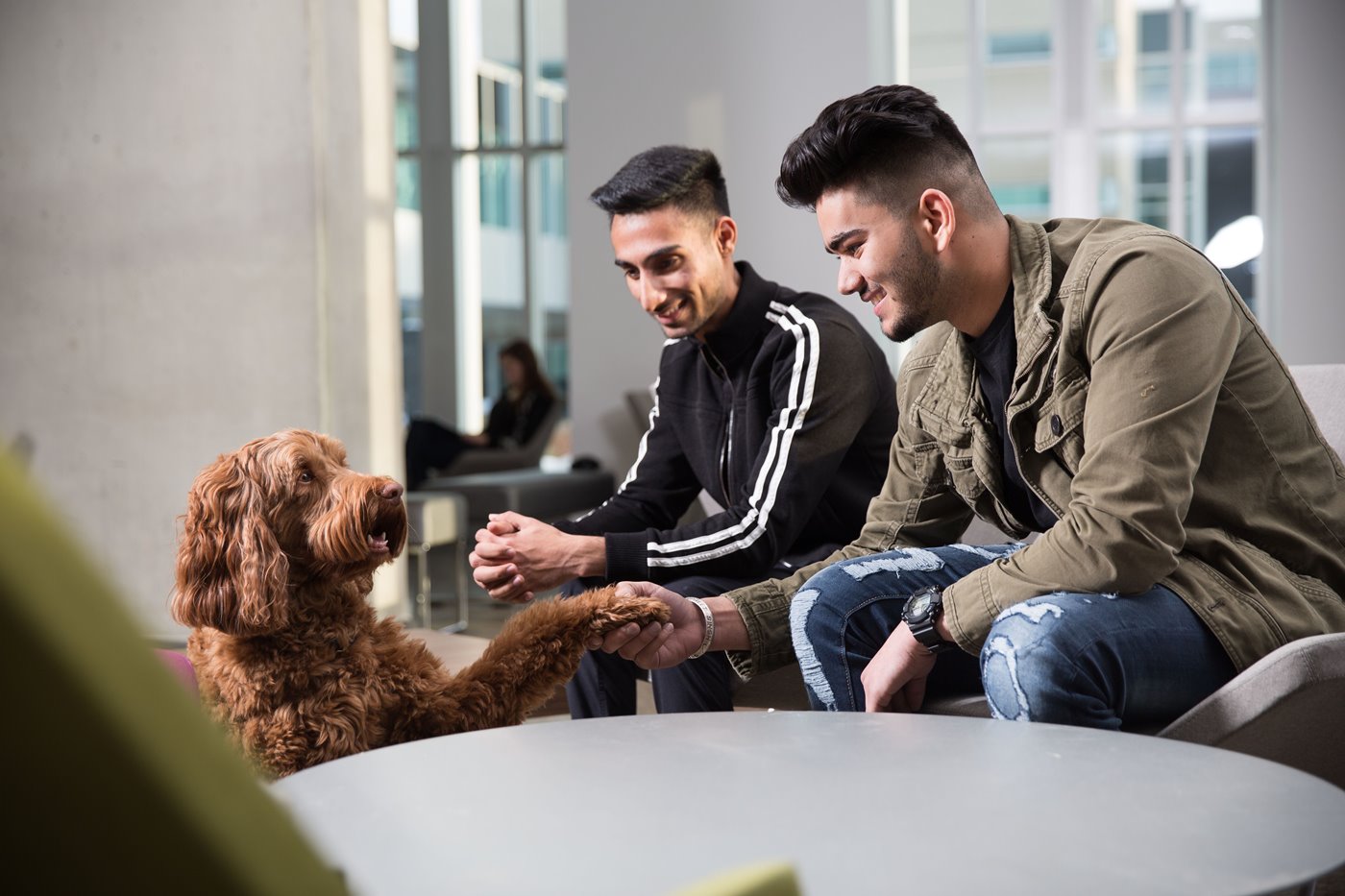.aspx?width=1000&height=660&ext=.jpg)
Support shows how Flynn and assisted animal therapy helps reduce stress and anxiety
Most students and staff know that Flynn, NAIT’s wellness dog, is more than a pet. He’s a member of the staff – and even has his own employee card!
The five-year-old Australian Labradoodle’s adorable furry face has been a fixture around NAIT campuses since 2013. He has many skills that separate him from the average dog, including his main role supporting the well-being of students and staff.
Linda Shaw, a student well-being facilitator, is Flynn’s owner and handler. The therapy dog initiative began after Shaw noticed wellness animals were brought to other post-secondary campuses in Edmonton during exams and they were a hit with students.
“I thought, wouldn’t it be great for students to have access to a resident wellness dog when they really needed a break?” says Shaw, a registered nurse with a diploma of applied psychology and counselling.
Pet therapy lands at NAIT
After research and consideration of factors such as breed, size and allergenicity, she found Flynn. Shaw had him tested by an animal behaviourist to evaluate temperament and sociability.
 Shaw prepared herself for the role of handler by taking an animal assisted therapy certificate program. She also wrote a capstone project on Flynn, as a proposal to NAIT for the therapy dog program. Post-secondary institutions increasingly report that stress and anxiety levels among students are on the rise. Her own research, funded by Alberta Blue Cross, shows that many students reported improvements after interacting with Flynn.
Shaw prepared herself for the role of handler by taking an animal assisted therapy certificate program. She also wrote a capstone project on Flynn, as a proposal to NAIT for the therapy dog program. Post-secondary institutions increasingly report that stress and anxiety levels among students are on the rise. Her own research, funded by Alberta Blue Cross, shows that many students reported improvements after interacting with Flynn.
“Animals have a nurturing effect on people that helps reduce stress,” Shaw says. Pets release oxytocin, a hormone that makes us feel happy and trusting, which contributes to the human-animal bond, she adds.
After five years on the job, Flynn is one of NAIT’s most recognized faces on campus.
Madelyn Gillcrist (Business Administration ‘17) says Flynn helped her during a stressful time. She stopped into the Counselling Centre after discovering she had a reading disability, and eventually made frequent visits to see Flynn.
“He’s patient and calming and he helped alleviate my anxiety.”
“He’s just really mellow, he’s not jumpy or anything. He’s patient and calming and he helped alleviate my anxiety,” says Gillcrist.
Handler’s best friend
One of the most important aspects of training a therapy dog is the relationship and bond between handler and animal.
“He watches for my cues so he knows what to do in different settings and situations.”
“It’s so important to have a strong connection with the animal. He watches for my cues so he knows what to do in different settings and situations,” says Shaw.
In some cases, that could mean giving signals to avoid a passing student in a hallway because Shaw sees their body language and senses the student is afraid or may be avoiding him due to an allergy.
In a 6-month span dating back to September 2017, Flynn interacted with nearly 5,000 staff and students, roaming campus, visiting classrooms and attending events. He’s very popular during his weekly visits to the Stollery Children’s Hospital – a volunteer commitment that was part of Shaw’s training plan for Flynn.
“He loves children; he’s so happy at the Stollery and just wants to get in every bed.”
Stop by for a visit
Students and staff can visit Flynn and get their snuggles in by stopping at PAWS for a Break sessions around campus. Flynn visits a different location every month, where staff and student participation is consistently high.
Demand is so strong, Shaw says she is looking forward to adding a second therapy dog – another Australian Labradoodle – to share duties with Flynn. Training is expected to begin this fall.
Published on April 28, 2018
Share this page:
.aspx?width=1000&height=660&ext=.jpg)
Therapy dogs have a PAWS-itive effect on students
Support confirms how Flynn and assisted animal therapy helps reduce stress and anxiety one student at a time.
Share on Facebook